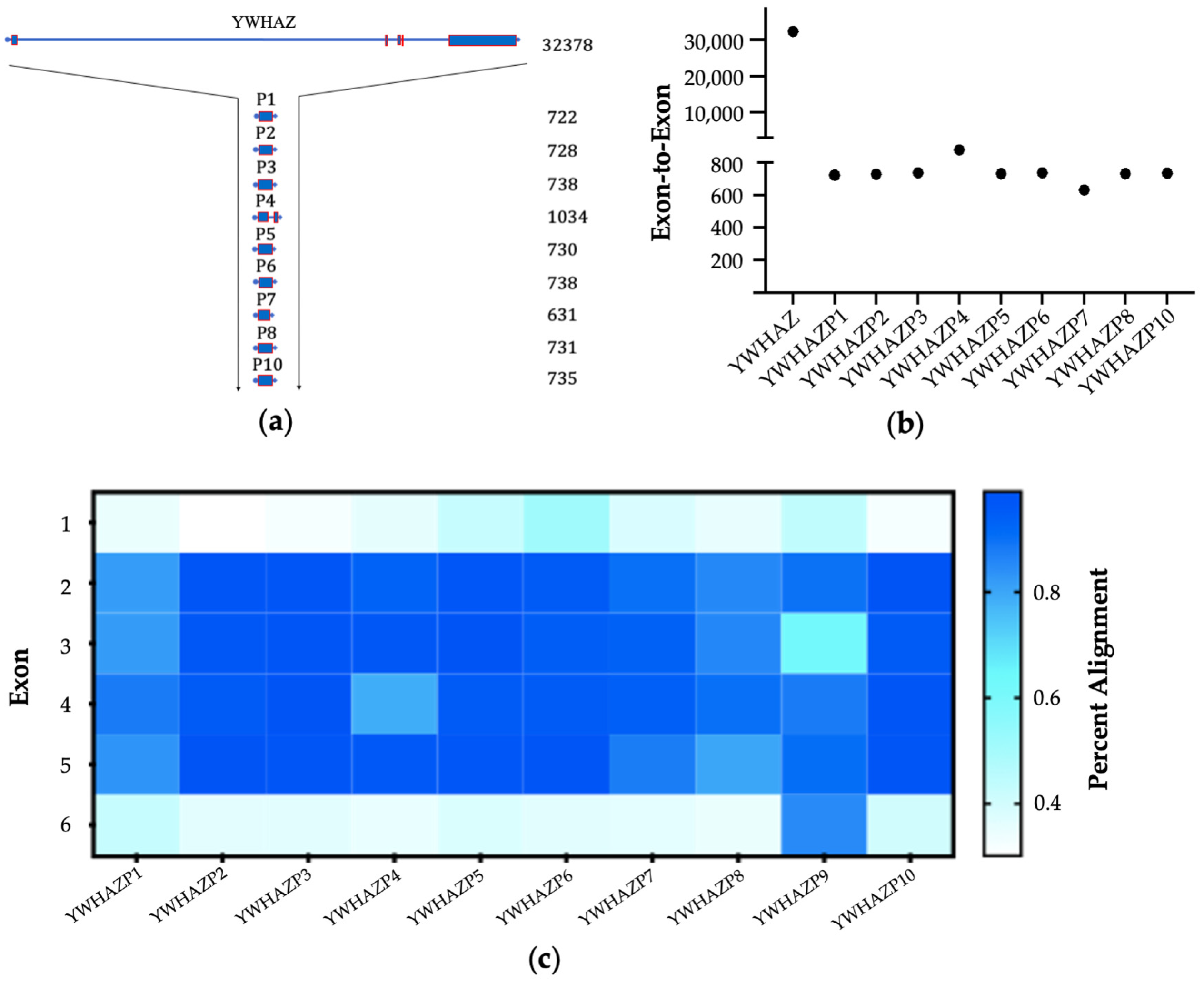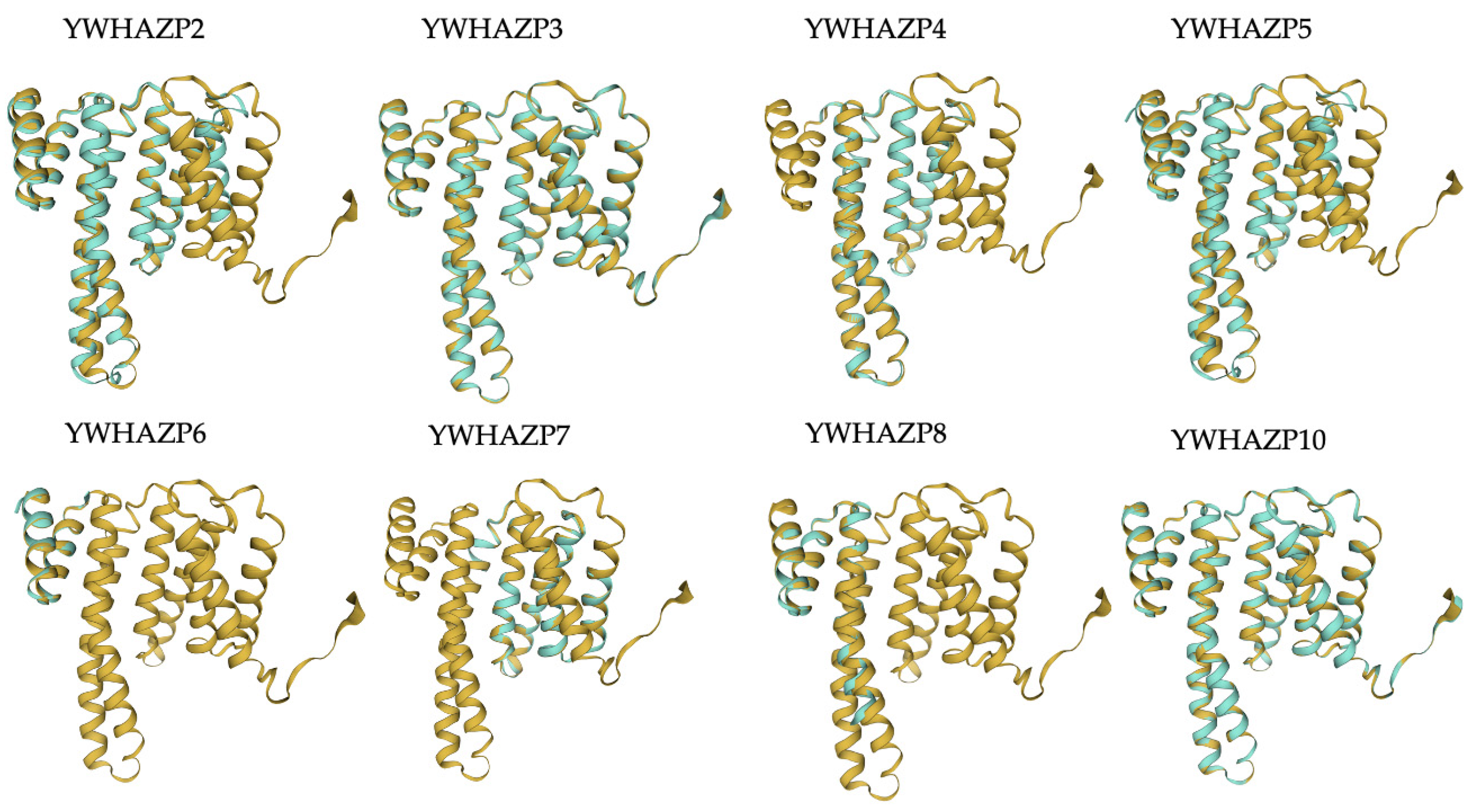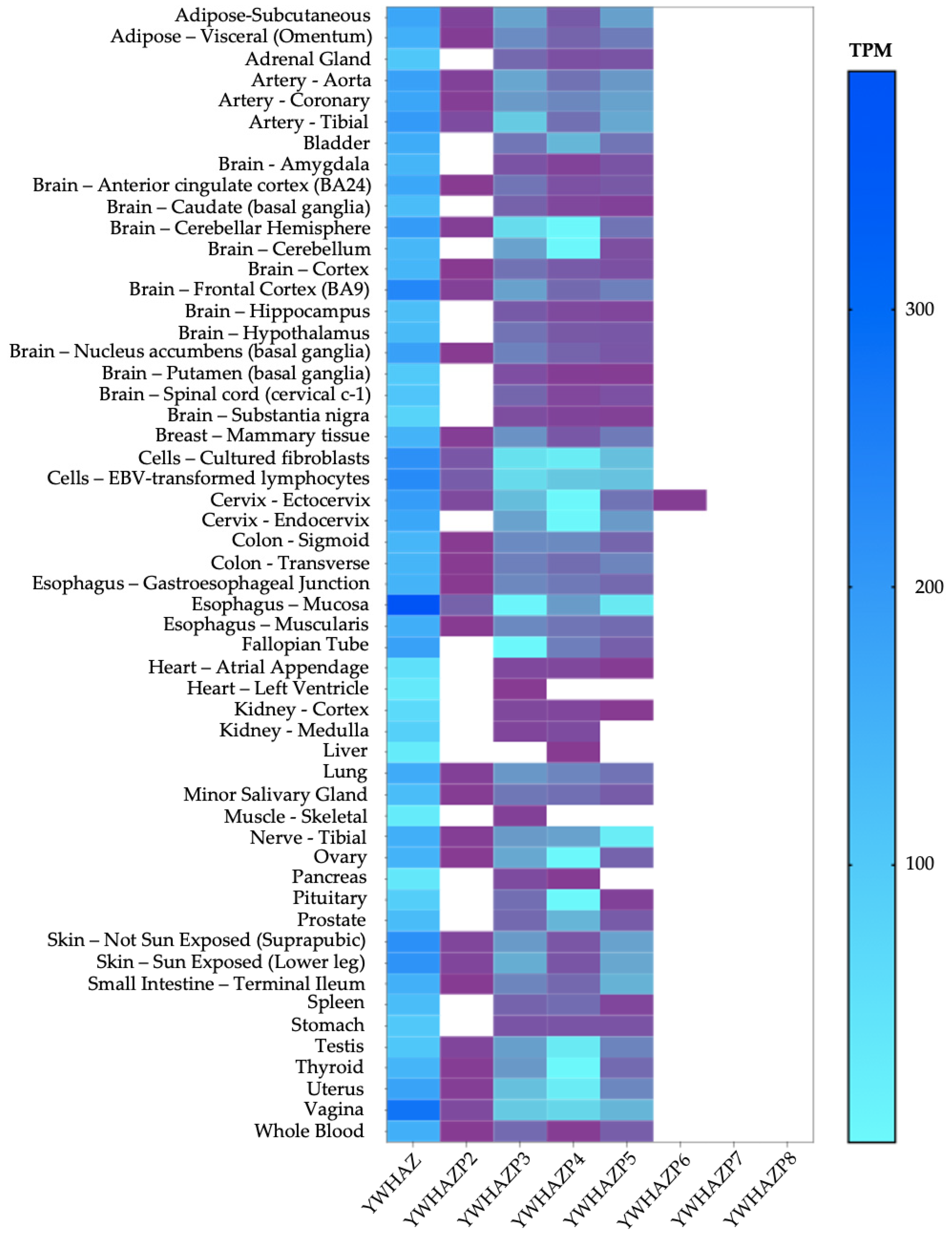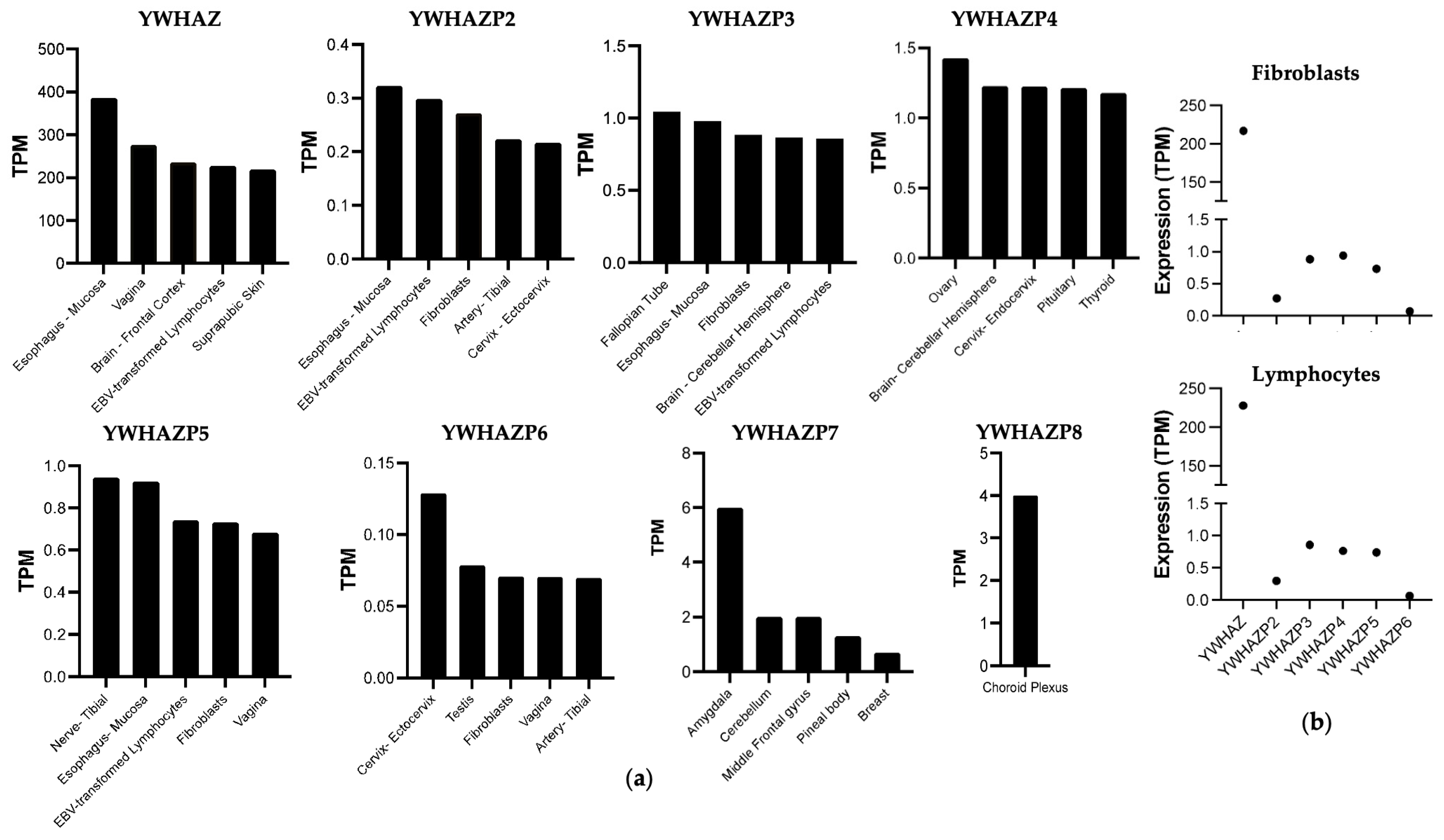Structural Features and Physiological Associations of Human 14-3-3ζ Pseudogenes
Abstract
1. Introduction
2. Materials and Methods
2.1. Genetic Features
2.2. Sequence Alignment and Analysis
Genome Browsers
- Vega: https://vega.archive.ensembl.org/Homo_sapiens/Search/Results?q=ywhaz;site=vega;facet_feature_type=;facet_species=Human;perpage=50 (accessed on 25 February 2024)
- GTEX: https://gtexportal.org/home/gene/YWHAZ, https://gtexportal.org/home/gene/YWHAE (accessed on 25 February 2024)
- ENSEMBL: https://useast.ensembl.org/Human/Search/Results?q=ywhazp;site=ensembl;facet_species=Human (accessed on 25 February 2024)
- Consensus CDS Protein Set: https://www.ncbi.nlm.nih.gov/CCDS/CcdsBrowse.cgi?REQUEST=CCDS&DATA=CCDS6290.1 (accessed on 25 February 2024)
- EBI Expression Atlas: https://www.ebi.ac.uk/gxa/experiments/E-MTAB-2836 (accessed on 25 February 2024)
2.3. Expression Data
2.4. Structure Simulation
2.5. Association with Human Disease
3. Results
3.1. YWHAZ Pseudogenes in Human Genome
3.2. Characteristics of Pseudogenes
3.3. Putative Pseudogene-Derived Proteins and 14-3-3ζ
3.4. Expression of Pseudogenes
3.5. Physiological Aspect of Pseudogenes
| Gene | Genomic Loci | Diseases | Reference |
|---|---|---|---|
| YWHAZ | 8q22.3 | Developmental delays, Intellectual disability, dysmorphism, Amyotrophic lateral sclerosis, Attention deficit hyperactivity disorder, Heart function. | [19,39,41,42,44,45,46] |
| YWHAZP1 | 14q21.2 | Migraines and expression in psoriatic arthritic leukocytes. | [53,58] |
| YWHAZP2 | 2q14.3 | Expression in Psoriatic Rheumatoid Arthritic T-Cells, elevated expression in LPS-treated PBMC of juvenile idiopathic arthritis patients. | [58,60] |
| YWHAZP3 | 10p12.2 | Expression in Psoriatic Rheumatoid Arthritis leukocytes and T-Cells as well sa expression in rheumatoid arthritic synovial macrophages. The gene has elevated expression in LPS-treated PBMC of juvenile idiopathic arthritis patients. | [58,59,60] |
| YWHAZP4 | 6q22.33 | Intellectual Disability, a transcriptomic marker in synovial macrophages for patients in remission with rheumatoid arthritis. | [48,59] |
| YWHAZP5 | 10q25.1 | Chromosomal region associated with Coffin-Lowry Syndrome, Expression in Psoriatic Rheumatoid Arthritic leukocytes, and 1 of 40 biomarkers for immune thrombocytopenia. | [49,58,62] |
| YWHAZP6 | 9p13.3 | Expression in Psoriatic arthritic leukocytes, contains a copy number gain variant associated with developmental delay. | [63] ClinVar Accession: VCV000151955.1 |
| YWHAZP7 | Xq11.2 | Chromosomal region Xq11.1–Xq11.2 found to be amplified in study of glioblastoma cells. | [64] |
| YWHAZP8 | Xq13.2 | Xq13.2-q21.31 duplication found in boy with recurrent seizures and pubertal gynecomastia. | [51] |
| YWHAZP10 | Xp11.4 | Associated with hyperammonemia and X-linked intellectual disability. Also expressed in synovial macrophages in rheumatoid arthritis and in LPS-treated PBMC of juvenile idiopathic arthritis patients. | [51,52,59,60] |
| Chromosomal Loci | Cancer |
|---|---|
| chrX:41,420,046–41,420,852 | Lymphoma, Breast |
| chr6:127,717,472–127,720,031 | Colon, Kidney |
| chr15:43,132,056–43,133,113 | Prostate, Gastric |
| chrX:41,417,881–41,420,027 | Cervical, Lymphoma |
| chr2:127,030,021–127,032,314 | Cervical, Gastric |
| chr10:107,436,038–107,439,382 | Cervical, Colon |
| chr10:23,465,825–23,468,573 | Cervical, Gastric |
| chr9:34,911,199–34,912,896 | Cervical, Lymphoma |
| chr6:127,720,001–127,722,735 | Colon, Prostate |
| chr6:50,779,065–50,779,689 | MPN, Cervical |
| chr15:43,136,038–43,136,973 | Prostate, Melanoma |
| chr12:17,408,254–17,409,509 | MPN, Bladder |
| chr11:59,601,362–59,604,558 | Cervical, Colon |
| chr15:43,136,038–43,136,973 | Prostate, Melanoma |
| chr12:17,408,254–17,409,509 | MPN, Bladder |
| chr11:59,601,362–59,604,558 | Cervical, Colon |
4. Discussion
5. Conclusions
Supplementary Materials
Author Contributions
Funding
Institutional Review Board Statement
Informed Consent Statement
Data Availability Statement
Acknowledgments
Conflicts of Interest
References
- Salmena, L. Pseudogene redux with new biological significance. Methods Mol. Biol. 2014, 1167, 3–13. [Google Scholar] [CrossRef]
- Zhang, Z.; Gerstein, M. Large-scale analysis of pseudogenes in the human genome. Curr. Opin. Genet. Dev. 2004, 14, 328–335. [Google Scholar] [CrossRef]
- Troskie, R.L.; Faulkner, G.J.; Cheetham, S.W. Processed pseudogenes: A substrate for evolutionary innovation: Retrotransposition contributes to genome evolution by propagating pseudogene sequences with rich regulatory potential throughout the genome. Bioessays 2021, 43, e2100186. [Google Scholar] [CrossRef] [PubMed]
- Pei, B.; Sisu, C.; Frankish, A.; Howald, C.; Habegger, L.; Mu, X.J.; Harte, R.; Balasubramanian, S.; Tanzer, A.; Diekhans, M.; et al. The GENCODE pseudogene resource. Genome Biol. 2012, 13, R51. [Google Scholar] [CrossRef] [PubMed]
- Djebali, S.; Davis, C.A.; Merkel, A.; Dobin, A.; Lassmann, T.; Mortazavi, A.; Tanzer, A.; Lagarde, J.; Lin, W.; Schlesinger, F.; et al. Landscape of transcription in human cells. Nature 2012, 489, 101–108. [Google Scholar] [CrossRef] [PubMed]
- Kabza, M.; Kubiak, M.R.; Danek, A.; Rosikiewicz, W.; Deorowicz, S.; Polanski, A.; Makalowska, I. Inter-population Differences in Retrogene Loss and Expression in Humans. PLoS Genet. 2015, 11, e1005579. [Google Scholar] [CrossRef]
- Ji, Z.; Song, R.; Regev, A.; Struhl, K. Many lncRNAs, 5’UTRs, and pseudogenes are translated and some are likely to express functional proteins. Elife 2015, 4, e08890. [Google Scholar] [CrossRef] [PubMed]
- Lister, N.; Shevchenko, G.; Walshe, J.L.; Groen, J.; Johnsson, P.; Vidarsdottir, L.; Grander, D.; Ataide, S.F.; Morris, K.V. The molecular dynamics of long noncoding RNA control of transcription in PTEN and its pseudogene. Proc. Natl. Acad. Sci. USA 2017, 114, 9942–9947. [Google Scholar] [CrossRef] [PubMed]
- Ma, Y.; Liu, S.; Gao, J.; Chen, C.; Zhang, X.; Yuan, H.; Chen, Z.; Yin, X.; Sun, C.; Mao, Y.; et al. Genome-wide analysis of pseudogenes reveals HBBP1’s human-specific essentiality in erythropoiesis and implication in beta-thalassemia. Dev. Cell 2021, 56, 478–493.e11. [Google Scholar] [CrossRef]
- Dubois, M.L.; Meller, A.; Samandi, S.; Brunelle, M.; Frion, J.; Brunet, M.A.; Toupin, A.; Beaudoin, M.C.; Jacques, J.F.; Levesque, D.; et al. UBB pseudogene 4 encodes functional ubiquitin variants. Nat. Commun. 2020, 11, 1306. [Google Scholar] [CrossRef]
- McGowan, J.; Peter, C.; Kim, J.; Popli, S.; Veerman, B.; Saul-McBeth, J.; Conti, H.; Pruett-Miller, S.M.; Chattopadhyay, S.; Chakravarti, R. 14-3-3zeta-TRAF5 axis governs interleukin-17A signaling. Proc. Natl. Acad. Sci. USA 2020, 117, 25008–25017. [Google Scholar] [CrossRef] [PubMed]
- Molzan, M.; Ottmann, C. Synergistic binding of the phosphorylated S233- and S259-binding sites of C-RAF to one 14-3-3zeta dimer. J. Mol. Biol. 2012, 423, 486–495. [Google Scholar] [CrossRef]
- Xu, X.; Jaehne, E.J.; Greenberg, Z.; McCarthy, P.; Saleh, E.; Parish, C.L.; Camera, D.; Heng, J.; Haas, M.; Baune, B.T.; et al. 14-3-3zeta deficient mice in the BALB/c background display behavioural and anatomical defects associated with neurodevelopmental disorders. Sci. Rep. 2015, 5, 12434. [Google Scholar] [CrossRef] [PubMed]
- Cheah, P.S.; Ramshaw, H.S.; Thomas, P.Q.; Toyo-Oka, K.; Xu, X.; Martin, S.; Coyle, P.; Guthridge, M.A.; Stomski, F.; van den Buuse, M.; et al. Neurodevelopmental and neuropsychiatric behaviour defects arise from 14-3-3zeta deficiency. Mol. Psychiatry 2012, 17, 451–466. [Google Scholar] [CrossRef] [PubMed]
- Kim, J.; Chun, K.; McGowan, J.; Zhang, Y.; Czernik, P.J.; Mell, B.; Joe, B.; Chattopadhyay, S.; Holoshitz, J.; Chakravarti, R. 14-3-3zeta: A suppressor of inflammatory arthritis. Proc. Natl. Acad. Sci. USA 2021, 118, e2025257118. [Google Scholar] [CrossRef] [PubMed]
- Benhuri, B.; Eljack, A.; Kahaleh, B.; Chakravarti, R. Mechanism and biomarkers in aortitis--a review. J. Mol. Med. 2020, 98, 11–23. [Google Scholar] [CrossRef] [PubMed]
- Chakravarti, R. Immune regulations by 14-3-3: A misty terrain. Immunobiology 2021, 226, 152145. [Google Scholar] [CrossRef] [PubMed]
- Vilahur, G.; Gutierrez, M.; Arzanauskaite, M.; Mendieta, G.; Ben-Aicha, S.; Badimon, L. Intracellular platelet signalling as a target for drug development. Vasc. Pharmacol. 2018, 111, 22–25. [Google Scholar] [CrossRef] [PubMed]
- Gan, Y.; Ye, F.; He, X.X. The role of YWHAZ in cancer: A maze of opportunities and challenges. J. Cancer 2020, 11, 2252–2264. [Google Scholar] [CrossRef]
- Yeh, H.W.; Lee, S.S.; Chang, C.Y.; Lang, Y.D.; Jou, Y.S. A New Switch for TGFbeta in Cancer. Cancer Res. 2019, 79, 3797–3805. [Google Scholar] [CrossRef]
- Diallo, K.; Oppong, A.K.; Lim, G.E. Can 14-3-3 proteins serve as therapeutic targets for the treatment of metabolic diseases? Pharmacol. Res. 2019, 139, 199–206. [Google Scholar] [CrossRef] [PubMed]
- Consortium, G.T. The Genotype-Tissue Expression (GTEx) project. Nat. Genet. 2013, 45, 580–585. [Google Scholar] [CrossRef]
- Cunningham, F.; Allen, J.E.; Allen, J.; Alvarez-Jarreta, J.; Amode, M.R.; Armean, I.M.; Austine-Orimoloye, O.; Azov, A.G.; Barnes, I.; Bennett, R.; et al. Ensembl 2022. Nucleic Acids Res. 2022, 50, D988–D995. [Google Scholar] [CrossRef] [PubMed]
- Martin, F.J.; Amode, M.R.; Aneja, A.; Austine-Orimoloye, O.; Azov, A.G.; Barnes, I.; Becker, A.; Bennett, R.; Berry, A.; Bhai, J.; et al. Ensembl 2023. Nucleic Acids Res. 2023, 51, D933–D941. [Google Scholar] [CrossRef] [PubMed]
- Bogard, N.; Linder, J.; Rosenberg, A.B.; Seelig, G. A Deep Neural Network for Predicting and Engineering Alternative Polyadenylation. Cell 2019, 178, 91–106.e123. [Google Scholar] [CrossRef]
- Nishikawa, T.; Ota, T.; Isogai, T. Prediction whether a human cDNA sequence contains initiation codon by combining statistical information and similarity with protein sequences. Bioinformatics 2000, 16, 960–967. [Google Scholar] [CrossRef] [PubMed]
- Gardiner-Garden, M.; Frommer, M. CpG islands in vertebrate genomes. J. Mol. Biol. 1987, 196, 261–282. [Google Scholar] [CrossRef] [PubMed]
- Thompson, J.D.; Higgins, D.G.; Gibson, T.J. CLUSTAL W: Improving the sensitivity of progressive multiple sequence alignment through sequence weighting, position-specific gap penalties and weight matrix choice. Nucleic Acids Res. 1994, 22, 4673–4680. [Google Scholar] [CrossRef] [PubMed]
- Brown, N.P.; Leroy, C.; Sander, C. MView: A web-compatible database search or multiple alignment viewer. Bioinformatics 1998, 14, 380–381. [Google Scholar] [CrossRef]
- Wheeler, D.L.; Church, D.M.; Federhen, S.; Lash, A.E.; Madden, T.L.; Pontius, J.U.; Schuler, G.D.; Schriml, L.M.; Sequeira, E.; Tatusova, T.A.; et al. Database resources of the National Center for Biotechnology. Nucleic Acids Res. 2003, 31, 28–33. [Google Scholar] [CrossRef]
- Needleman, S.B.; Wunsch, C.D. A general method applicable to the search for similarities in the amino acid sequence of two proteins. J. Mol. Biol. 1970, 48, 443–453. [Google Scholar] [CrossRef]
- Crooks, G.E.; Hon, G.; Chandonia, J.M.; Brenner, S.E. WebLogo: A sequence logo generator. Genome Res. 2004, 14, 1188–1190. [Google Scholar] [CrossRef] [PubMed]
- Jumper, J.; Evans, R.; Pritzel, A.; Green, T.; Figurnov, M.; Ronneberger, O.; Tunyasuvunakool, K.; Bates, R.; Zidek, A.; Potapenko, A.; et al. Highly accurate protein structure prediction with AlphaFold. Nature 2021, 596, 583–589. [Google Scholar] [CrossRef]
- Waterhouse, A.; Bertoni, M.; Bienert, S.; Studer, G.; Tauriello, G.; Gumienny, R.; Heer, F.T.; de Beer, T.A.P.; Rempfer, C.; Bordoli, L.; et al. SWISS-MODEL: Homology modelling of protein structures and complexes. Nucleic Acids Res. 2018, 46, W296–W303. [Google Scholar] [CrossRef] [PubMed]
- Landrum, M.J.; Lee, J.M.; Riley, G.R.; Jang, W.; Rubinstein, W.S.; Church, D.M.; Maglott, D.R. ClinVar: Public archive of relationships among sequence variation and human phenotype. Nucleic Acids Res. 2014, 42, D980–D985. [Google Scholar] [CrossRef] [PubMed]
- Firth, H.V.; Richards, S.M.; Bevan, A.P.; Clayton, S.; Corpas, M.; Rajan, D.; Van Vooren, S.; Moreau, Y.; Pettett, R.M.; Carter, N.P. DECIPHER: Database of Chromosomal Imbalance and Phenotype in Humans Using Ensembl Resources. Am. J. Hum. Genet. 2009, 84, 524–533. [Google Scholar] [CrossRef] [PubMed]
- McGowan, J.E.; Kratch, J.; Chattopadhyay, S.; Joe, B.; Conti, H.R.; Chakravarti, R. Bioinformatic analysis reveals new determinants of antigenic 14-3-3 proteins and a novel antifungal strategy. PLoS ONE 2017, 12, e0189503. [Google Scholar] [CrossRef] [PubMed]
- Pink, R.C.; Wicks, K.; Caley, D.P.; Punch, E.K.; Jacobs, L.; Carter, D.R. Pseudogenes: Pseudo-functional or key regulators in health and disease? RNA 2011, 17, 792–798. [Google Scholar] [CrossRef] [PubMed]
- McGowan, J.; Peter, C.; Chattopadhyay, S.; Chakravarti, R. 14-3-3zeta-A Novel Immunogen Promotes Inflammatory Cytokine Production. Front. Immunol. 2019, 10, 1553. [Google Scholar] [CrossRef]
- Yan, S.; Shang, Q.; Fan, Z.; Yang, Y.; Liu, Y.; Gao, H.; Chen, K.; Liang, F.; Li, X.; Zhang, Q.; et al. Expression of PD-L1 and YWHAZ in Patients with Diffuse Large B Cell Lymphoma: A Possible Association with the Prognosis of Lymphoma. J. Immunol. Res. 2022, 2022, 5633096. [Google Scholar] [CrossRef]
- Glenfield, C.; McLysaght, A. Pseudogenes Provide Evolutionary Evidence for the Competitive Endogenous RNA Hypothesis. Mol. Biol. Evol. 2018, 35, 2886–2899. [Google Scholar] [CrossRef]
- Kong, J.S.; Park, J.H.; Yoo, S.A.; Kim, K.M.; Bae, Y.J.; Park, Y.J.; Cho, C.S.; Hwang, D.; Kim, W.U. Dynamic transcriptome analysis unveils key proresolving factors of chronic inflammatory arthritis. J. Clin. Investig. 2020, 130, 3974–3986. [Google Scholar] [CrossRef]
- Popov, I.K.; Hiatt, S.M.; Whalen, S.; Keren, B.; Ruivenkamp, C.; van Haeringen, A.; Chen, M.J.; Cooper, G.M.; Korf, B.R.; Chang, C. A YWHAZ Variant Associated With Cardiofaciocutaneous Syndrome Activates the RAF-ERK Pathway. Front. Physiol. 2019, 10, 388. [Google Scholar] [CrossRef] [PubMed]
- Wan, R.P.; Liu, Z.G.; Huang, X.F.; Kwan, P.; Li, Y.P.; Qu, X.C.; Ye, X.G.; Chen, F.Y.; Zhang, D.W.; He, M.F.; et al. YWHAZ variation causes intellectual disability and global developmental delay with brain malformation. Hum. Mol. Genet. 2023, 32, 462–472. [Google Scholar] [CrossRef]
- Mugabo, Y.; Zhao, C.; Tan, J.J.; Ghosh, A.; Campbell, S.A.; Fadzeyeva, E.; Pare, F.; Pan, S.S.; Galipeau, M.; Ast, J.; et al. 14-3-3zeta Constrains insulin secretion by regulating mitochondrial function in pancreatic beta cells. JCI Insight 2022, 7, e156378. [Google Scholar] [CrossRef]
- Nishimura, Y.; Komatsu, S.; Ichikawa, D.; Nagata, H.; Hirajima, S.; Takeshita, H.; Kawaguchi, T.; Arita, T.; Konishi, H.; Kashimoto, K.; et al. Overexpression of YWHAZ relates to tumor cell proliferation and malignant outcome of gastric carcinoma. Br. J. Cancer 2013, 108, 1324–1331. [Google Scholar] [CrossRef] [PubMed]
- Chakravarti, R.; Gupta, K.; Swain, M.; Willard, B.; Scholtz, J.; Svensson, L.G.; Roselli, E.E.; Pettersson, G.; Johnston, D.R.; Soltesz, E.G.; et al. 14-3-3 in Thoracic Aortic Aneurysms: Identification of a Novel Autoantigen in Large Vessel Vasculitis. Arthritis Rheumatol. 2015, 67, 1913–1921. [Google Scholar] [CrossRef] [PubMed]
- Jaehne, E.J.; Ramshaw, H.; Xu, X.; Saleh, E.; Clark, S.R.; Schubert, K.O.; Lopez, A.; Schwarz, Q.; Baune, B.T. In-vivo administration of clozapine affects behaviour but does not reverse dendritic spine deficits in the 14-3-3zeta KO mouse model of schizophrenia-like disorders. Pharmacol. Biochem. Behav. 2015, 138, 1–8. [Google Scholar] [CrossRef] [PubMed]
- Mackenroth, L.; Hackmann, K.; Beyer, A.; Schallner, J.; Novotna, B.; Klink, B.; Schrock, E.; Di Donato, N. 6q22.33 microdeletion in a family with intellectual disability, variable major anomalies, and behavioral abnormalities. Am. J. Med. Genet. A 2015, 167, 2800–2807. [Google Scholar] [CrossRef]
- McCandless, S.E.; Schwartz, S.; Morrison, S.; Garlapati, K.; Robin, N.H. Adult with an interstitial deletion of chromosome 10 [del(10)(q25. 1q25.3)]: Overlap with Coffin-Lowry syndrome. Am. J. Med. Genet. 2000, 95, 93–98. [Google Scholar] [CrossRef]
- Linhares, N.D.; Valadares, E.R.; da Costa, S.S.; Arantes, R.R.; de Oliveira, L.R.; Rosenberg, C.; Vianna-Morgante, A.M.; Svartman, M. Inherited Xq13.2-q21.31 duplication in a boy with recurrent seizures and pubertal gynecomastia: Clinical, chromosomal and aCGH characterization. Meta Gene 2016, 9, 185–190. [Google Scholar] [CrossRef] [PubMed]
- Dubbs, H.; Ortiz-Gonzalez, X.; Marsh, E.D. Pathogenic variants in CASK: Expanding the genotype-phenotype correlations. Am. J. Med. Genet. A 2022, 188, 2617–2626. [Google Scholar] [CrossRef] [PubMed]
- McPheron, M.; Lah, M. Survival of a Male Infant with a Familial Xp11.4 Deletion Causing Ornithine Transcarbamylase Deficiency. JIMD Rep. 2019, 45, 83–87. [Google Scholar] [CrossRef] [PubMed]
- Soragna, D.; Vettori, A.; Carraro, G.; Marchioni, E.; Vazza, G.; Bellini, S.; Tupler, R.; Savoldi, F.; Mostacciuolo, M.L. A locus for migraine without aura maps on chromosome 14q21.2-q22.3. Am. J. Hum. Genet. 2003, 72, 161–167. [Google Scholar] [CrossRef] [PubMed]
- Xu, C.; Zhang, R.; Duan, M.; Zhou, Y.; Bao, J.; Lu, H.; Wang, J.; Hu, M.; Hu, Z.; Zhou, F.; et al. A polygenic stacking classifier revealed the complicated platelet transcriptomic landscape of adult immune thrombocytopenia. Mol. Ther. Nucleic Acids 2022, 28, 477–487. [Google Scholar] [CrossRef] [PubMed]
- Canello, T.; Shahar, T.; Zelikovitch, B.; Mordechai, A.; Lossos, A.; Lavon, I. Geno-23amplification of chromosome xq11.1–xq11.2 might play a role in glioblastoma. Neuro-Oncology 2015, 17, v96. [Google Scholar] [CrossRef][Green Version]
- Best, M.G.; Sol, N.; Kooi, I.; Tannous, J.; Westerman, B.A.; Rustenburg, F.; Schellen, P.; Verschueren, H.; Post, E.; Koster, J.; et al. RNA-Seq of Tumor-Educated Platelets Enables Blood-Based Pan-Cancer, Multiclass, and Molecular Pathway Cancer Diagnostics. Cancer Cell 2015, 28, 666–676. [Google Scholar] [CrossRef] [PubMed]
- Kalyana-Sundaram, S.; Kumar-Sinha, C.; Shankar, S.; Robinson, D.R.; Wu, Y.M.; Cao, X.; Asangani, I.A.; Kothari, V.; Prensner, J.R.; Lonigro, R.J.; et al. Expressed pseudogenes in the transcriptional landscape of human cancers. Cell 2012, 149, 1622–1634. [Google Scholar] [CrossRef] [PubMed]
- Penkava, F.; Velasco-Herrera, M.D.C.; Young, M.D.; Yager, N.; Nwosu, L.N.; Pratt, A.G.; Lara, A.L.; Guzzo, C.; Maroof, A.; Mamanova, L.; et al. Single-cell sequencing reveals clonal expansions of pro-inflammatory synovial CD8 T cells expressing tissue-homing receptors in psoriatic arthritis. Nat. Commun. 2020, 11, 4767. [Google Scholar] [CrossRef]
- Alivernini, S.; MacDonald, L.; Elmesmari, A.; Finlay, S.; Tolusso, B.; Gigante, M.R.; Petricca, L.; Di Mario, C.; Bui, L.; Perniola, S.; et al. Distinct synovial tissue macrophage subsets regulate inflammation and remission in rheumatoid arthritis. Nat. Med. 2020, 26, 1295–1306. [Google Scholar] [CrossRef]
- Cepika, A.M.; Banchereau, R.; Segura, E.; Ohouo, M.; Cantarel, B.; Goller, K.; Cantrell, V.; Ruchaud, E.; Gatewood, E.; Nguyen, P.; et al. A multidimensional blood stimulation assay reveals immune alterations underlying systemic juvenile idiopathic arthritis. J. Exp. Med. 2017, 214, 3449–3466. [Google Scholar] [CrossRef] [PubMed]
- Merling, R.K.; Kuhns, D.B.; Sweeney, C.L.; Wu, X.; Burkett, S.; Chu, J.; Lee, J.; Koontz, S.; Di Pasquale, G.; Afione, S.A.; et al. Gene-edited pseudogene resurrection corrects p47(phox)-deficient chronic granulomatous disease. Blood Adv. 2017, 1, 270–278. [Google Scholar] [CrossRef] [PubMed]
- Hawkins, P.G.; Morris, K.V. Transcriptional regulation of Oct4 by a long non-coding RNA antisense to Oct4-pseudogene 5. Transcription 2010, 1, 165–175. [Google Scholar] [CrossRef] [PubMed]
- Kim, M.S.; Pinto, S.M.; Getnet, D.; Nirujogi, R.S.; Manda, S.S.; Chaerkady, R.; Madugundu, A.K.; Kelkar, D.S.; Isserlin, R.; Jain, S.; et al. A draft map of the human proteome. Nature 2014, 509, 575–581. [Google Scholar] [CrossRef] [PubMed]
- Kaplan, A.; Bueno, M.; Fournier, A.E. Extracellular functions of 14-3-3 adaptor proteins. Cell Signal 2017, 31, 26–30. [Google Scholar] [CrossRef] [PubMed]
- Liu, J.; Cao, S.; Ding, G.; Wang, B.; Li, Y.; Zhao, Y.; Shao, Q.; Feng, J.; Liu, S.; Qin, L.; et al. The role of 14-3-3 proteins in cell signalling pathways and virus infection. J. Cell Mol. Med. 2021, 25, 4173–4182. [Google Scholar] [CrossRef]
- Grander, D.; Johnsson, P. Pseudogene-Expressed RNAs: Emerging Roles in Gene Regulation and Disease. Curr. Top. Microbiol. Immunol. 2016, 394, 111–126. [Google Scholar] [CrossRef]





| Gene | ID | Chromosome | Strand | Locus | Nucleotide Region | DNA Length (bp) | mRNA Length (bp) |
|---|---|---|---|---|---|---|---|
| YWHAZ | ENSG00000164924 | 8 | Reverse | 8q22.3 | 100,916,523–100,953,388 | 32,378 | 5011 |
| YWHAZP1 | ENSG00000259148 | 14 | Reverse | 14q21.2 | 44,290,997–44,291,718 | 722 | 722 |
| YWHAZP2 | ENSG00000213236 | 2 | Reverse | 2q14.3 | 126,557,435–126,558,162 | 728 | 728 |
| YWHAZP3 | ENSG00000229932 | 10 | Forward | 10p12.2 | 23,136,924–23,137,661 | 738 | 738 |
| YWHAZP4 | ENSG00000213131 | 6 | Forward | 6q22.33 | 127,355,756–127,356,789 | 1034 | 708 |
| YWHAZP5 | ENSG00000213260 | 10 | Forward | 10q25.1 | 105,686,322–105,687,051 | 730 | 730 |
| YWHAZP6 | ENSG00000215199 | 9 | Reverse | 9p13.3 | 34,922,184–34,922,921 | 738 | 738 |
| YWHAZP7 | ENSG00000227261 | X | Reverse | Xq11.2 | 64,612,632–64,613,262 | 631 | 631 |
| YWHAZP8 | ENSG00000225664 | X | Forward | Xq13.2 | 73,274,785–73,275,515 | 731 | 731 |
| YWHAZP10 | ENSG00000217624 | X | Reverse | Xp11.4 | 41,675,760–41,676,494 | 735 | 735 |
| Gene | DNA Alignment (%) | cDNA Alignment (%) | Amino Acid Alignment (%) | PolyA Tail | Kozak Sequence | CpG Island (#) | Exons | Initiation Codon | Nature of Pseudogene |
|---|---|---|---|---|---|---|---|---|---|
| YWHAZ | 100 | YES | GXXATGG | 3176 | 6 | ATG | |||
| YWHAZP1 | 19 | 80.6 | YES | 1 | Processed | ||||
| YWHAZP2 | 32 | 97.1 | 93.8 | YES | GXXATGG | 62 | 1 | ATG | Processed |
| YWHAZP3 | 31 | 97.6 | 97.6 | YES | GXXATGG | 1 | ATG | Processed | |
| YWHAZP4 | 42 | 90.5 | 86.7 | YES | CXXATGG | 2 | CTG/ATG | Processed | |
| YWHAZP5 | 15 | 96 | 90.1 | NO | GXXATGG | 1 | ATG | Processed | |
| YWHAZP6 | 32 | 95.1 | 97.1 | NO | GXXATGG | 1 | ATG | Processed | |
| YWHAZP7 | 24 | 88.4 | 80.4 | YES | 1 | TTG | Processed | ||
| YWHAZP8 | 28 | 85.2 | 80.7 | YES | 1 | TTG | Processed | ||
| YWHAZP10 | 32 | 98.0 | 95.5 | YES | GXXATGG | 195 | 1 | ATG | Processed |
Disclaimer/Publisher’s Note: The statements, opinions and data contained in all publications are solely those of the individual author(s) and contributor(s) and not of MDPI and/or the editor(s). MDPI and/or the editor(s) disclaim responsibility for any injury to people or property resulting from any ideas, methods, instructions or products referred to in the content. |
© 2024 by the authors. Licensee MDPI, Basel, Switzerland. This article is an open access article distributed under the terms and conditions of the Creative Commons Attribution (CC BY) license (https://creativecommons.org/licenses/by/4.0/).
Share and Cite
Lughmani, H.; Patel, H.; Chakravarti, R. Structural Features and Physiological Associations of Human 14-3-3ζ Pseudogenes. Genes 2024, 15, 399. https://doi.org/10.3390/genes15040399
Lughmani H, Patel H, Chakravarti R. Structural Features and Physiological Associations of Human 14-3-3ζ Pseudogenes. Genes. 2024; 15(4):399. https://doi.org/10.3390/genes15040399
Chicago/Turabian StyleLughmani, Haroon, Hrushil Patel, and Ritu Chakravarti. 2024. "Structural Features and Physiological Associations of Human 14-3-3ζ Pseudogenes" Genes 15, no. 4: 399. https://doi.org/10.3390/genes15040399
APA StyleLughmani, H., Patel, H., & Chakravarti, R. (2024). Structural Features and Physiological Associations of Human 14-3-3ζ Pseudogenes. Genes, 15(4), 399. https://doi.org/10.3390/genes15040399







